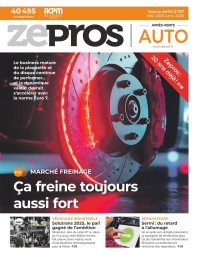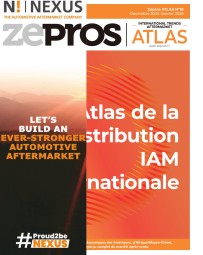
“Limiting our innovations to electric vehicles alone would be a strategic error”

In a rebounding replacement market, exclusive interview with Gary Guthrie, Senior VP automotive Global Brands Business Line at Michelin, for the latest International IAM distribution of Zepros…
Can you give us some figures on Michelin’s global results in 2024 in passenger cars and vans?
Gary Guthrie: In the first nine months of the year, the OE market is in the red with a fall of 3% and some inconsistencies by region*. Europe is down 6%, North America down 1%, and South America down 5%. Africa and the Middle East is down 2% and Asian countries excluding China down 8%. But the Chinese market grew by 1%. Original equipment is inherently cyclical, so we are at a low point. And combined with a sum of negative factors, the cocktail is rather bitter mixing the environmental transition, stagnation of the Chinese market, declining purchasing power and increasing uncertainty among consumers regarding their choice of engine. We all know that in a subsidised market such as electric vehicles, the end of government subsidies causes sales of electric vehicles to drop off in favour of hybrids. The parts market is up 3%, driven by Europe with an increase of 7%, North America is up 3% and China down1%. For cars and light commercial alone, which cover 50% of sales, the overall turnover over nine months is €10.3 billion, down 2.4% on 2023.
Why are parts sales bouncing back?
GG: Several factors explain this recovery. Firstly, the market is aging and expanding. Secondly, annual mileage is returning to pre-crisis levels of 2019. Additionally, workshops are experiencing a "catch-up effect," addressing delayed maintenance and repairs. As a result, consumer sales for distributors have grown. However, this growth—driven notably by Europe acting as a key driver—will likely stabilise due to the natural replacement cycle of parts. In contrast, China has underperformed in this sector, facing challenges from a tough consumer environment despite government efforts to stimulate spending.
How is Michelin responding to the influx of Asian tyres in Europe?
GG: The wave of Chinese tyres in Europe—driven by overcapacity in China and restricted access to other markets like the US—is primarily seen in older tyre segments. Michelin's strategy to counter this focuses on producing tyres with superior performance and durability. For instance, even when worn down to 1.6 mm, Michelin tyres maintain performance levels that can surpass some new tyres in safety, grip, and rolling resistance. Additionally, there is a trend boosting our position: the growing demand for premium tyres of 18 inches and above, such as those used on SUVs, with an average annual growth of 9%. Michelin is well-aligned with this trend and continues to excel in this segment.
Where are your investing to meet environmental requirements?
GG: Reducing the carbon footprint is indeed a very important issue and Michelin has invested considerably in improving its environmental impact throughout the life cycle of its tyres. From the sourcing of raw materials to manufacturing, including transport, use, collection and recovery, each step has been optimised to minimise its ecological footprint. More than 80% of the environmental impact of a tyre comes from its use on the road, largely through its contribution to the vehicle's CO2 emissions and wear particle emissions. These issues are now considered by regulatory authorities, who are establishing increasingly strict standards.
Michelin has reduced the rolling resistance of its tyres, lowering this value from 12 kg to 5 kg per tonne. A recent study conducted by ADAC also demonstrated that the abrasion resistance of Michelin tyres is 28% higher than the average of other manufacturers. This demonstrates the group's commitment to sustainability and innovation in the tyre industry.
What are the major global challenges facing Michelin?
GG: Sustainable individual mobility is the major challenge for the automotive industry. Electric vehicles appear to be an essential long-term solution, but currently represent only 2% of the global vehicle parc and is expected to reach between 10 and 12% by 2030. But the contribution of tyres to sustainability goes well beyond the impact of electric vehicles. The rolling resistance of tyres represents around 20% of a vehicle's energy consumption, which results in a significant proportion of CO2 emissions and operational costs. The particle emissions generated by tyre wear are equivalent to those of a Euro 6 ICE engine. In this context, Michelin is focusing on deploying its technologies on the largest possible scale. Limiting these innovations to electric vehicles alone would be a strategic error. That is why all Michelin tyres are now “EV Ready”, allowing consumers to choose the tyre best suited to their needs, while simplifying the offer for distributors, without requiring specific EV ranges.
Are alliances like GDSO** crucial to sustaining the tyre industry? GDSO advocate for embedding RFID chips in every tyre and Michelin is an active member
GG: It's the way things are heading. Two years ago, Michelin, Pirelli, Goodyear, Bridgestone, and Continental took the lead in creating GDSO, a standardised system integrated into an RFID (Radio Frequency Identification) chip embedded in the sidewall of each tyre. This chip allows for the complete tracking of a tyre throughout its lifecycle—covering details like the manufacturer, serial number, production, usage, and eventual recovery or disposal. This innovation represents a significant technological advancement for the entire industry under the GDSO initiative. However, its success depends on widespread adoption by all industry players.
*Source: Michelin Financial Report
**Global Data Service Organisation







